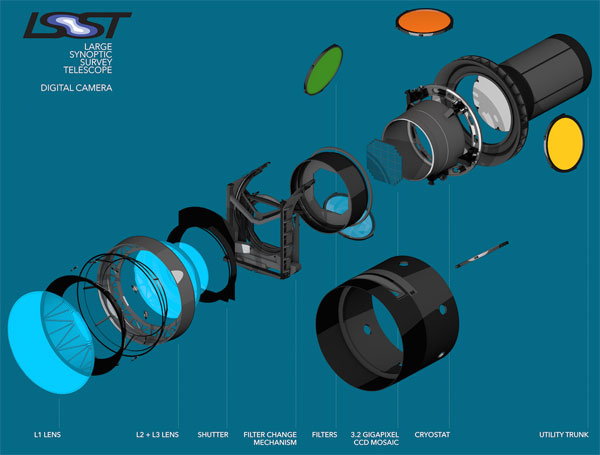The SLAC National Accelerator Laboratory will begin procuring components for a $168 million, 3.2-GP CCD telescope camera following final approval from the U.S. Department of Energy late last month.
The Large Synoptic Survey Telescope (LSST), set for completion in 2022, will take digital images of the entire visible southern sky every few nights from atop a mountain called Cerro Pachón in Chile. It will produce a wide, deep and fast survey of the night sky, cataloguing by far the largest number of stars and galaxies ever observed.

An exploded view of the LSST’s digital camera
highlights its various components, including lenses, shutter and
filters. Courtesy of the SLAC National Accelerator Laboratory.
The telescope’s camera — the size of a small car and weighing more than 3 tons — will take about five years to build. Capable of viewing light from near-ultraviolet to near-infrared (0.3- to 1-μm) wavelengths, it will capture full-sky images at such high resolution that it would take 1500 high-definition television screens to display just one of them.
The camera design calls for a focal plane array of 189 4K × 4K CCD sensors with 10-μm pixels. The sensors are deep-depletion, back-illuminated devices with a highly segmented architecture that enables the entire array to be read out in 2 s.
A nearly 2000-square-foot, two-story-tall cleanroom has already been built at SLAC to accommodate fabrication of the camera.
Components of the camera are being built by an international collaboration of universities and labs, including SLAC (the Standford University linear accelerator center) and Brookhaven and Lawrence Livermore national laboratories. SLAC is responsible for overall project management and systems engineering, camera body design and fabrication, data acquisition and camera control software, cryostat design and fabrication, and integration and testing of the entire camera.
"We're also excited about the wide range of scientific opportunities offered by LSST, in particular increasing our understanding of dark energy," said SLAC Director Chi-Chang Kao.
SLAC is also designing and constructing the database for the telescope's data management system.
LSST will generate a public archive of approximately 6 million GB per year. This data will help researchers study the formation of galaxies, track potentially hazardous asteroids, observe exploding stars and better understand dark matter and dark energy, which together make up 95 percent of the universe but whose natures remain unknown.
Meanwhile, the LSST's dual-surface primary/tertiary mirror — the first of its kind for a major telescope — was completed in May by the University of Arizona. It is now in long-term storage at Tucson International Airport.
Funding for the camera comes from the Department of Energy, while financial support for the telescope and site facilities, the data management system and the education and public outreach infrastructure of LSST comes primarily from the National Science Foundation.